International Toy Fair Nuremberg 2009
Internationale Spielwarenmesse Nürnberg 2009
| x |
|
|
|
|
|
|
|
|
|
|
|
|
|
|
|
|
|
|
|
|
|
|
|
|
|
|
|
|
|
|
|
|
|
| Asmodee |
|
| x |
|
|
|
|
|
|
|
|
|
|
|
|
|
|
|
|
|
|
|
|
|
|
|
|
|
|
|
|
|
|
|
|
|
 |
In Bakong, players have to find their way through the Cambodian jungle which in fact are a set of tiles that trigger various events. At the end lies the temple of Bakong where valuable emeralds are stored. The player who has made it to there and finishes first in returning to the base camp, has won.
In a turn, a player rolls two dice and takes two actions: turn over a tile, and move his adventurer. For movement, he may use either dice. The player turns over the tile that corresponds with the die roll he has chosen. The other die roll is the one that is used for moving his adventurer. Yellow tiles stop movement, red tiles may injure the adventurer or make him lose an item. On his way, he can collect emeralds that he can store in his rucksack.
The goal of the journey is the temple, as here are the large emeralds stored. The largest with a value of 17 has a curse on it, as long as it is carried, an adventurer cannot benefit from the effects of the waterfall tile that may recover him from any injuries. |
|
| x |
|
|
|
|
|
|
|
|
|
|
|
|
|
|
|
|
|
|
|
|
|
|
|
|
|
|
|
|
|
|
|
|
|
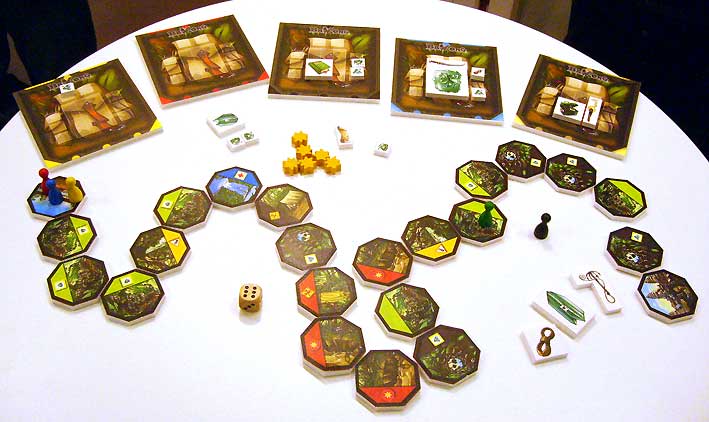 |
| x |
|
|
|
|
|
|
|
|
|
|
|
|
|
|
|
|
|
|
|
|
|
|
|
|
|
|
|
|
|
|
|
|
|
On some jungle tiles, players may collect a small emerald if they stop on them. Caves also are a good place to stop by: the player rolls two dice and may take the amount of small emeralds, but he must have enough space in his rucksack to carry all these. Rivers prevent movement but not for the adventurer who has everything with him, in this case rope. Cliffs are another form of obstacle, not to speak of pitfalls that cause an injury; an affected player must take an 'ouch' marker that are -3 point per marker at game end.
But now for the good things: even for adventurers it is good to have a first aid kit with them; from now on he may ignore red pit tiles and he does not collect 'ouch' counters. An explorer's handbook is good for a reroll of both dice, and a machete does allow a player to move an additional tile. The torch may come in handy in caves, where it is good for picking up extra emeralds, and the possession of a map allows a player to turn over a second tile. Finally the compass allows careful movement: a player may move one tile less than the die roll chosen.
Bakong, Antoine Bauza, Asmodee, 2009 - 2 to 6 players, 7 years and up, 30 minutes |
|
| x |
|
|
|
|
|
|
|
|
|
|
|
|
|
|
|
|
|
|
|
|
|
|
|
|
|
|
|
|
|
|
|
|
|
 |
| x |
|
|
|
|
|
|
|
|
|
|
|
|
|
|
|
|
|
|
|
|
|
|
|
|
|
|
|
|
|
|
|
|
|
| x |
|
|
|
|
|
|
|
|
|
|
|
|
|
|
|
|
|
|
|
|
|
|
|
|
|
|
|
|
|
|
|
|
|
| x |
|
|
|
|
|
|
|
|
|
|
|
|
|
|
|
|
|
|
|
|
|
|
|
|
|
|
|
|
|
|
|
|
|
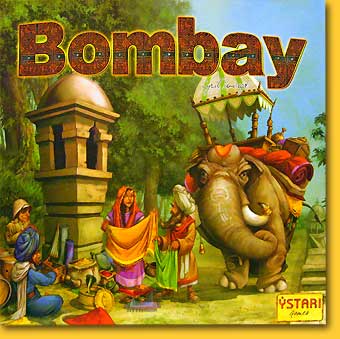 |
In 5 rounds with 4 phases, players try to buy and sell silk and build palaces. At game end, the richest player has won.
The starting player starts a phase with refilling silk cubes from a cloth bag, placing them by colour and amount on the various markets. Now each player may perform three actions and are free in the order, but may only buy one silk cube per phase.
Possible actions are:
-pass, and take three rupee from the bank;
- move the elephant to an adjacent field - when this goes to a hill it costs two actions;
- buy a silk cube at a trade post, with the scarcer silk costing more rupees and actions;
- sell a silk cube in a town; the colour must match the demand of the city as shown on the tile that is next to it. The upper colour on the tile pays out four rupee, the lowest only one, but also a customer chit. Bonuses are given for yellow and purple cubes. |
|
| x |
|
|
|
|
|
|
|
|
|
|
|
|
|
|
|
|
|
|
|
|
|
|
|
|
|
|
|
|
|
|
|
|
|
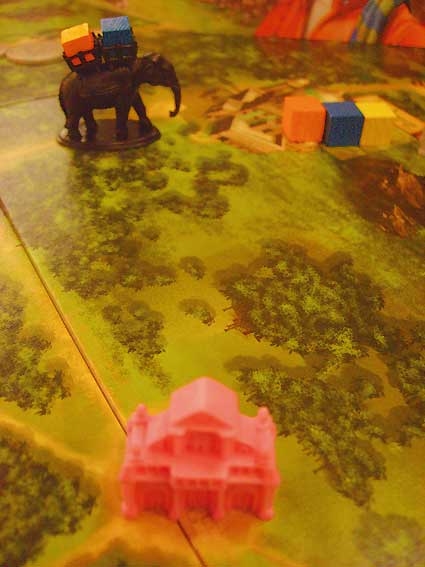 |
x |
After the sale, the demands on the tile are adjusted - the sold cube now is at the bottom, with the other two silk types increasing in revenue. When a player did not yet have a city marker of this city, he takes one and places it behind his player screen.
- a player could choose to build a palace. His elephant must be on an empty space and for one action and one silk cube of any type he may place a palace of his colour.
|
|
| x |
|
|
|
|
|
|
|
|
|
|
|
|
|
|
|
|
|
|
|
|
|
|
|
|
|
|
|
|
|
|
|
|
|
Whenever a player enters a field with a palace belonging to another player, the owner gets one rupee from the bank. At the end of the game, palaces bring in extra rupees.
Certain fields contain palace markers that go to players when they build a palace on that field; the player takes the marker and immediately performs the action that goes with it. One acts as an additional customer chit, another as an additional city marker that increases a players score at game end; the other two pay out two rupee or one silk cube. |
|
| x |
|
|
|
|
|
|
|
|
|
|
|
|
|
|
|
|
|
|
|
|
|
|
|
|
|
|
|
|
|
|
|
|
|
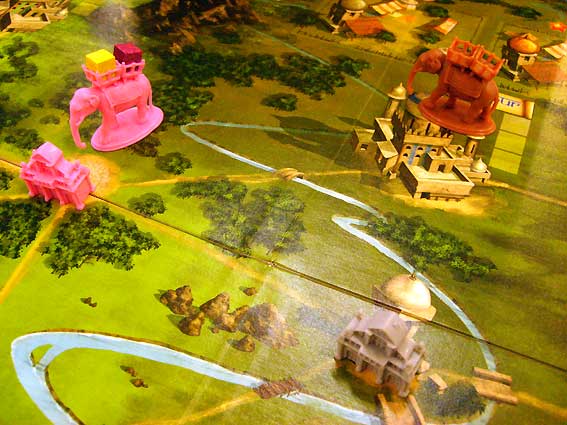 |
| x |
|
|
|
|
|
|
|
|
|
|
|
|
|
|
|
|
|
|
|
|
|
|
|
|
|
|
|
|
|
|
|
|
|
At game end, all players count their palaces andcustomers chits. The player with the highest score gets 8 rupee, the second 4, and the third 2. Three city markers pay out 4 rupee; a player with 4 city markers even gets 8 rupee. Now each player counts his money; the richest player has won the game.
For 2, 3, and 5 players different rules apply. |
|
| x |
|
|
|
|
|
|
|
|
|
|
|
|
|
|
|
|
|
|
|
|
|
|
|
|
|
|
|
|
|
|
|
|
|
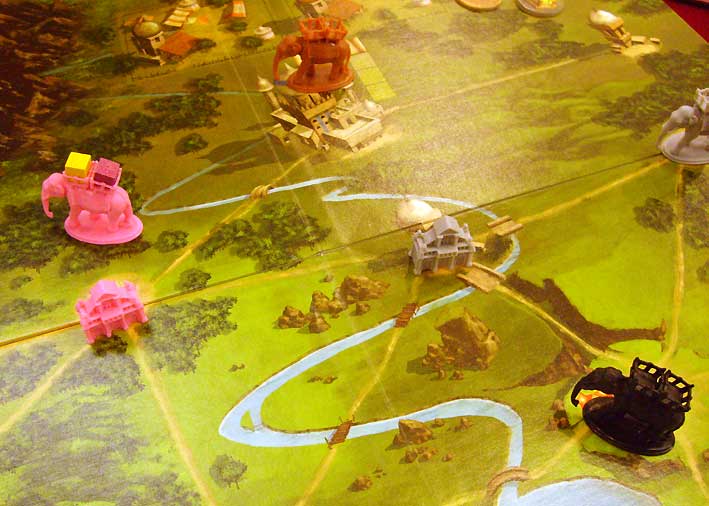 |
| x |
|
|
|
|
|
|
|
|
|
|
|
|
|
|
|
|
|
|
|
|
|
|
|
|
|
|
|
|
|
|
|
|
|
| Bombay, Cyril Demaegd, Ystari / Asmodee, 2009 - 2 to 5 players, 10 years and up, 45 minutes |
|
| x |
|
|
|
|
|
|
|
|
|
|
|
|
|
|
|
|
|
|
|
|
|
|
|
|
|
|
|
|
|
|
|
|
|
| x |
|
|
|
|
|
|
|
|
|
|
|
|
|
|
|
|
|
|
|
|
|
|
|
|
|
|
|
|
|
|
|
|
|
| x |
|
|
|
|
|
|
|
|
|
|
|
|
|
|
|
|
|
|
|
|
|
|
|
|
|
|
|
|
|
|
|
|
|
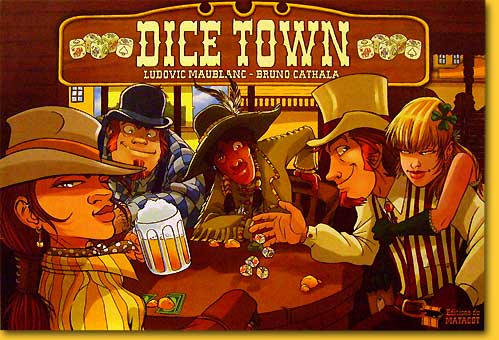 |
|
| x |
|
|
|
|
|
|
|
|
|
|
|
|
|
|
|
|
|
|
|
|
|
|
|
|
|
|
|
|
|
|
|
|
|
The dice cups in this game resemble Chocolate Kisses, a treat that before a more recent name change in many European countries was sold as Negro Kisses (each in its own language).
Each player gets a cup with five poker dice and eight dollar. Each turn a player will put together a poker hand and depending on the roll, take control of various key places in Dice Town that will allow him to perform the corresponding action of the location.
In a turn, all players shake their cup and take out all but one die which is kept apart. They repeat the process with the remaining dice until all five dice are on the tabl. Players may want to keep more than one die ; they pay one dollar for each additional die. Now the locations are checked: |
|
| x |
|
|
|
|
|
|
|
|
|
|
|
|
|
|
|
|
|
|
|
|
|
|
|
|
|
|
|
|
|
|
|
|
|
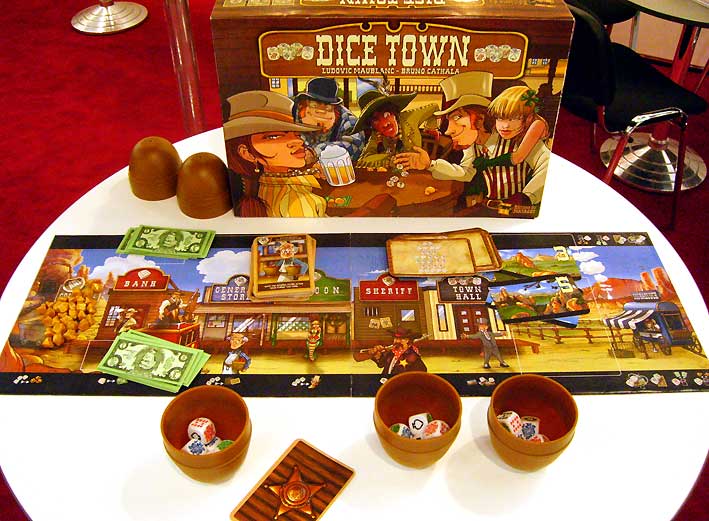 |
| x |
|
|
|
|
|
|
|
|
|
|
|
|
|
|
|
|
|
|
|
|
|
|
|
|
|
|
|
|
|
|
|
|
|
In the gold mine, the player with the most 9's may take one nugget from the mine for each nine he has thrown. In the bank, the player with the most 10's may rob the bank and take all bills there - each two bills represent one victory point at game end.
The player who has the most J's goes to the general store and draws as many cards as he had thrown J's, keeping one. These cards may give from one to eight points, or entitle a player to perform the saloon or general store action twice in a row, place a die with a result of a player's choice under the cup without rolling, or steal 4 dollar from an other player. There are many more cards of this kind that spice up the game. |
|
|
| x |
|
|
|
|
|
|
|
|
|
|
|
|
|
|
|
|
|
|
|
|
|
|
|
|
|
|
|
|
|
|
|
|
|
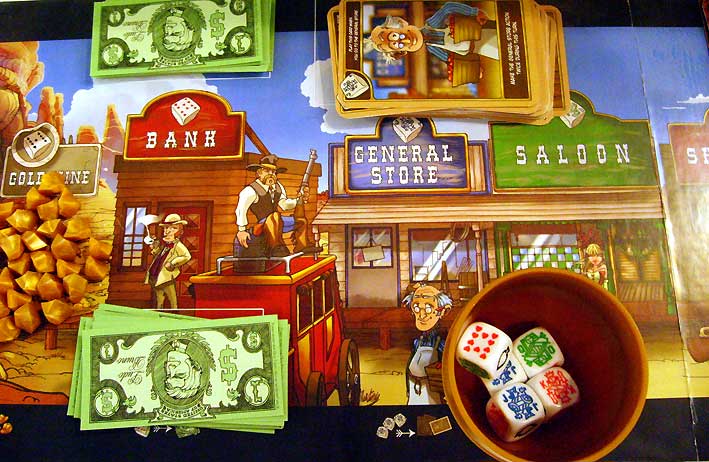 |
| x |
|
|
|
|
|
|
|
|
|
|
|
|
|
|
|
|
|
|
|
|
|
|
|
|
|
|
|
|
|
|
|
|
|
The player with the most Q's in his roll wins the favor of the girls, and takes advantage of their charm to steal from an opponent. He may take as many cards from him as he has thrown Q's, keeping one and giving back the others.
The player with the most K's becomes the new sheriff; he decides who wins in any ties, but the sheriff can be influenced with nuggets, cards or money.
In the town hall the player with the best poker hand gets a property claim that go from one to five victory points.
Finally, if a player did not win anything during a turn, he might visit Doc Badluck where he can choose any one of the following:
- equip oneself with barbed wire - the player has two property claims that cannot be stolen;
- draw the first card from the general store pile;
- all other players must give the player two dollar;
- an ace will bring a nugget from every other player.
The game ends when there are no more gold nuggets in the mine, or when all property claims have been issued. Players count their points: 1 for each nugget, 1 for every two dollar, 5 for whoever is currently sheriff, and each general store and property card for its value.
Dice Town, Ludovic Maublanc & Bruno Cathala, Editions du Matagot / Asmodee, 2009 - 2 to 5 players, 8 years and up, no time indication |
|
| x |
|
|
|
|
|
|
|
|
|
|
|
|
|
|
|
|
|
|
|
|
|
|
|
|
|
|
|
|
|
|
|
|
|
| x |
|
|
|
|
|
|
|
|
|
|
|
|
|
|
|
|
|
|
|
|
|
|
|
|
|
|
|
|
|
|
|
|
|
| x |
|
|
|
|
|
|
|
|
|
|
|
|
|
|
|
|
|
|
|
|
|
|
|
|
|
|
|
|
|
|
|
|
|
 |
If this game goes the same as 'Vinci' where it is based on, players go for the 120+ points they need in order to win. They choose one people from a window; each having unique and special abilities.
All fight for space on a - this time - fantasy map. After a turn, players count the areas they occupy and get points for them; some people get points for certain terrain. After a while, one needs to consider of rolling up one's people and taking a new one from the window. Maybe next turn; this turn still scores good...!
|
|
| x |
|
|
|
|
|
|
|
|
|
|
|
|
|
|
|
|
|
|
|
|
|
|
|
|
|
|
|
|
|
|
|
|
|
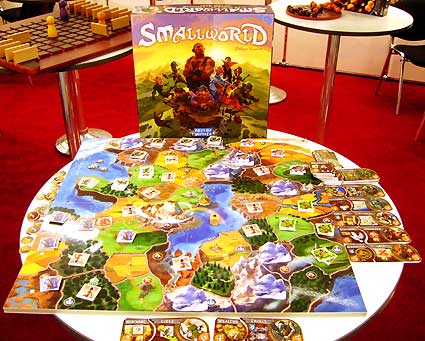
The map of 'Vinci' was somewhat dull but effective; 'Small World' shows a more colourful board; but will it be better for gameplay?
Small World, Phillippe Keyaerts, Days of Wonder / Asmodee, 2009 - 2 to 5 players, no age recommendation (12 years and up), 80 minutes |
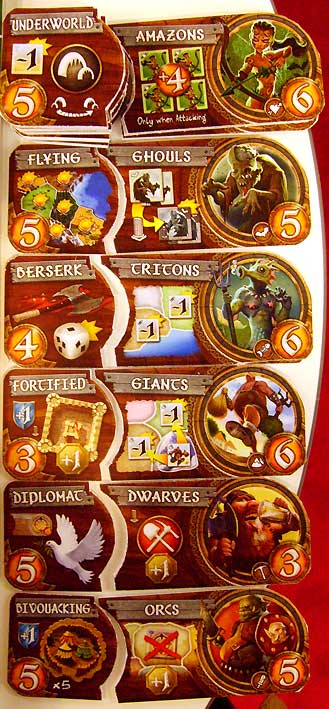 |
| x |
|
|
|
|
|
|
|
|
|
|
|
|
|
|
|
|
|
|
|
|
|
|
|
|
|
|
|
|
|
|
|
|
|
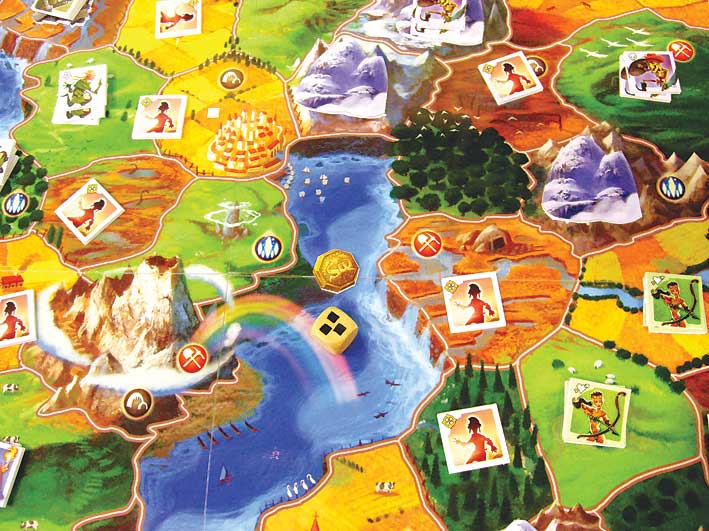 |
| x |
|
|
|
|
|
|
|
|
|
|
|
|
|
|
|
|
|
|
|
|
|
|
|
|
|
|
|
|
|
|
|
|
|
| x |
|
|
|
|
|
|
|
|
|
|
|
|
|
|
|
|
|
|
|
|
|
|
|
|
|
|
|
|
|
|
|
|
|
| x |
|
|
|
|
|
|
|
|
|
|
|
|
|
|
|
|
|
|
|
|
|
|
|
|
|
|
|
|
|
|
|
|
|
 |
|
|
|
|
|
|
|
|
|
|
|
|
|
|
|
|
|
|
|
|
|
|
 |
|
|
|
|
|
|
|
|
|
|
|
|
|
|
|
|
|
|
|
|
|
|
 |
|
|
|
|
|
|
|
|
|
|
|
|
|
|
|
|
|
|
|
|
|
|
 |
|
|
|
|
|
|
|
|
|
|
|
|
|
|
|
|
|
|
|
|
|
|
 |
|
|
|
|
|
|
|
|
|
|
|
|
|
|
|
|
|
|
|
|
|
|
| x |
|
|
|
|
|
|
|
|
|
|
|
|
|
|
|
|
|
|
|
|
|
|
|
|
|
|
|
|
|
|
|
|
|
 |
|
|
|
|
|
|
|
|
|
|
|
|
|
|
|
|
|
|
|
| x |
|
|
|
|
|
|
|
|
|
|
|
|
|
|
|
|
|
|
|
|
|
|
|
|
|
|
|
|
|
|
|
|
|
|
|